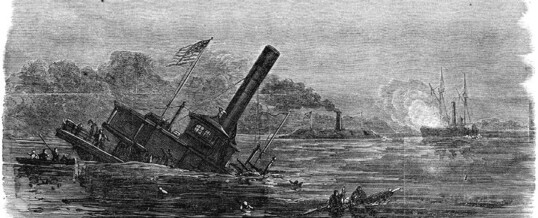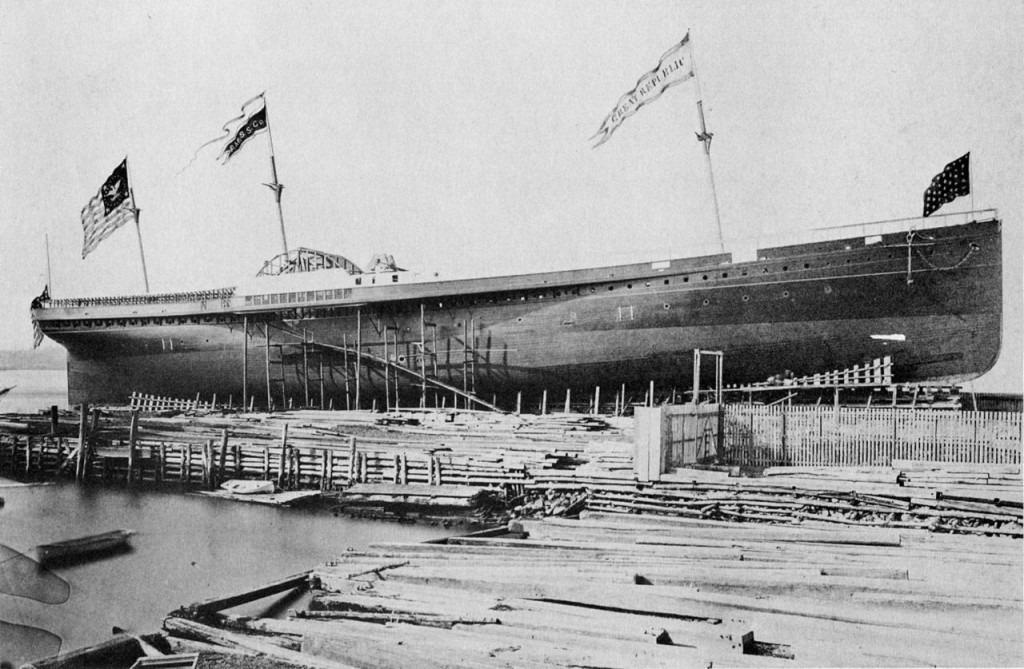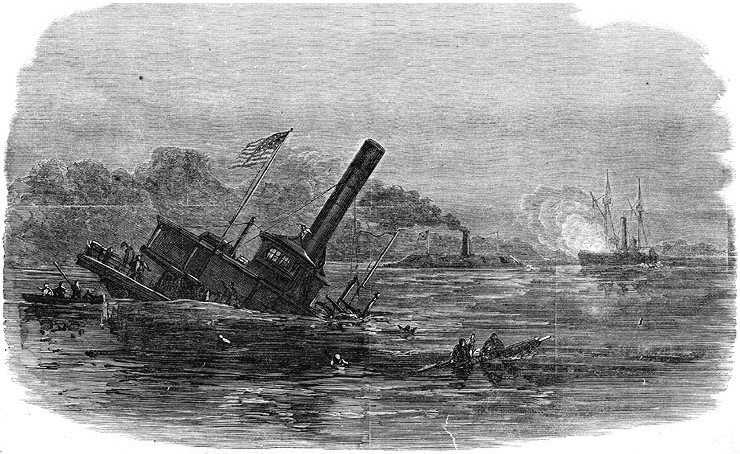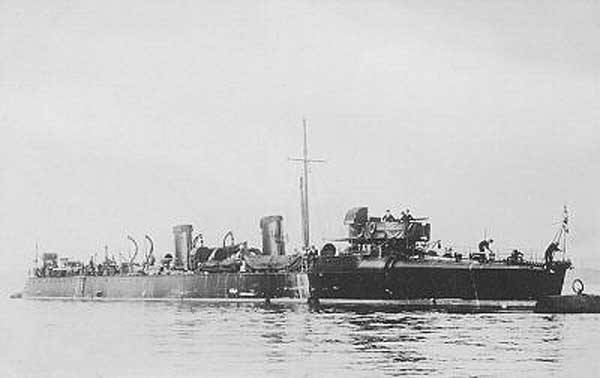
Today’s shipwrecks include one that was caused by a true “tempest in a teakettle.” Other wrecks range from a Spanish slave ship to the largest passenger liner of its time. And the two big mysteries for this day are whether the SS Gold Coast, torpedoed in 1917, was carrying gold bullion, and whether the SS Steelmaker torpedoed in 1942 was carrying cement or silver. If you are seeing this in a post, other than on Shipwrecks.com, read more about these wrecks and other ships lost on an April 19 at http://shipwrecks.com/shipwrecks-of-april-19/.
Today’s Shipwrecks™
April 19
compiled and edited by Dr. E. Lee Spence
1759: HMS Falcon was wrecked in the West Indies on April 19, 1759. She had been launched as a 14-gun sloop in 1745 and converted to an 8-gun bombardment ship in 1758.
1819: In April of 1819, the Spanish Guineaman (slave ship) Celesti, with 170 slaves on board, which had been captured off Abaco in the Bahamas by a privateer believed to be the Patriot, and part of the crew sent into New Providence aboard the Sally, was afterwards “wrecked near the West end of Grand Bahama; the slaves were taken on board the privateer Hornet, Captain Ornee, from Baltimore. It was thought that they would try to take the slaves to Georgia.”
1821: The American brig Favorite (or Favourite), 127 tons, Captain Hayward, bound from Kingston, Jamaica to Monte Cristi, was wrecked on April 19, 1821, at Port St. Jago, St. Domingo. Her crew was saved.
1829: The vessel Traveler, Captain Borrows, bound from Jamaica to Bermuda, struck on the Silver Keys (most likely the Silver Shoals, Dominican Republic) on April 19, 1829, and filled with water. She was afterwards towed into Caicos, and part of her cargo saved.
1838: A boat belonging to John Robbins, with three men in it, “capsized in a tempest in Teakettle Sound” near St. Catherine’s Island, Georgia, on April 19, 1838. A man named Coward was drowned. John Robbins was identified as being a Savannah pilot. (Note by ELS: Its easy to ascribe this as the source of the idiom “Tempest in a Teakettle,” but that idiom, often expressed as in a teapot or teacup, had already in use for at least a hundred years.)
1857: The British brig Wave, Captain King, bound from Kingston, Jamaica, for London, with a cargo of coffee, was totally wrecked on Long Cay, Crooked Island, in April of 1857. “The cargo was all saved by the shore people, and sold there for from $8.50 to $10 per hundred; salvage awarded, 60 percent. There are no capitalists at Long Cay, and as it is in the interest of a few to have the property sold there it generally happens that such is a fixed fact. It would be much more to the interest of the underwriters to have it brought to and sold at Nassau, where there are moneyed men and plenty of competition. Self interest appears to be the ruling passion of the day, and ‘more money’ the only precept inculcated.”
1861: The ship Witchcraft was on a northwest course with a northeast wind when she was wrecked within sight of the lights of both Hatteras and Body Island, North Carolina, sometime prior to April 19, 1861. The ship listed off shore when she went aground, thereby exposing her decks to the full force of a heavy sea. She went to pieces in an hour and a half. Fourteen of the thirty-one people aboard were lost. Captain John Hayes, late of the British ship John Phillips, which had been sold in Australia, was lost along with his wife and child. Her boats were all stove, and a man named Thomas Bliss told how he tried to swim for the beach, and succeeded in reaching it only after having drifted two miles southward. A seaman named Moses Smith died of exhaustion, and was buried on the beach. The chief mate, the second mate, the steward and the cook were also lost.
1864: The U.S.S. Southfield, Acting Volunteer Lieutenant Charles A. French commanding, with one hundred and seventeen men, was rammed and sunk in the Roanoke River by the Confederate States ram Albemarle on April 19, 1864. The steamer sank in less than fifteen minutes in twenty-two feet of water near the Camphor Battery, Plymouth, North Carolina. The Southfield had been lashed to the U.S.S. Miami for their mutual protection when she was rammed.
She was a double ended sidewheel steamer with a wooden hull. She was 781 tons, 200′ in length, 34′ in breadth and 11’8″ in depth, and 6’6″ in draft. She was armed with one 100-pounder Parrott rifle, five 9-inch Dahlgren smooth bores and one 12-pounder smooth bore. Her 100-pounder Parrott rifle and at least two of her 9-inch Dahlgrens were raised by the Confederates.
[Note by ELS: A report dated November 1, 1864, stated “We continued to advance to within a mile of the works (at Plymouth, North Carolina), when we discovered that the channel was obstructed at a point opposite the batteries by two schooners sunk one on each side of the wreck of the Southfield, which together formed a barrier which could only have been passed with great danger, if at all.” A diagram showing the position of the schooners and the Southfield appears on page 13, Volume 11, Series 2, of the “Official Records of the War of Rebellion” for the Union and Confederate Navies.]
1865: The United States steamer Enoch Dean, employed by the Freedman’s Bureau and carrying freedmen, their families and effects, struck a snag while passing through a creek leading into St. Catherine’s Sound, Georgia, and sank on April 19, 1865. The people were saved. The steamer also carried seeds and farming utensils. The Enoch Dean had left Savannah to carry the former slaves to some of the sea islands of Georgia where the people were to be settled in comfortable homes. The wooden hulled sidewheel steamer had one deck, no masts, no galleries, a round tuck, and a billet head. She measured 135’8″ in length, 25’10” in breadth, and 7′ in depth of hull, and was 194 33/95 tons. She was built at Keyport, New Jersey, in 1852, and her first home port was New York, New York. She was transferred to the War Department in 1863.
When lost, the Enoch Dean was acting under the direct orders of General Saxon, and was being used by him “to further, in various ways, his philanthropic endeavors to elevate the condition of the freedmen.”
1879: On April 19, 1879, the steamer Great Republic, with over 1000 passengers and crew, bound from Portland, Oregon, for San Francisco, was run aground on Sand Island, shortly after crossing the Columbia Bar at high tide. It was a clear and calm night and the grounding was attributed to the pilot’s failure to heed the captain’s warnings. Stranded on a falling tide with a storm approaching, the captain evacuated the 896 passengers on local boats. Her crew remained aboard hoping to re-float the vessel, but storm-driven waves began breaking up her hull, and they were forced to abandon ship. Everything went fine until the last boat, which overturned, resulting in the death of eleven men. Waves shortly quickly rendered the vessel a total loss, though parts of the wreckage remained visible at low tide for many years.
The Great Republic was launched from Henry Steers’s shipyard at Greenpoint, Long Island, New York, on Thursday, November 8, 1866, and was the largest ship of any kind that at that date had ever been built in United States for commercial purposes. She was the first of the ships built by Pacific Mail Steamship Company for the new line between San Francisco and China, and was 380 feet in length, 50 feet in width and 31 feet 6 inches in depth of hold. The Great Republic eventually proved unprofitable in the China trade and was sold in 1878 to P. B. Cornwall for service along the U.S. Pacific coast.

SS Great Republic under construction at the yard of Henry Steers, New York, 1866.
The wreck shouldn’t be too difficult to distinguish as we know a great deal about her. She was engined by the Novelty Iron Works and many of the parts made by that company, including such things as brass portholes, were well marked with their name. Her frame timbers were of white and live oak, fastened with copper and iron, and braced with straps of iron five inches wide and seven-eights of an inch thick, crossing each other diagonally every four feet. The inner planking was also double-strapped, and outside of the iron strapping was a double planking of Georgia yellow pine. The whole was thoroughly braced, and bolted together with three-nails of locust, iron, and composition spikes, and copper bolts. She had three masts, and was full ship-rigged, her foremast, however being the highest of the three, and her mizzenmast the shortest. She had three full decks, with an orlop deck fore and aft, extending to the engine bulk-head. She had four stout, water-tight bulk heads, dividing the hold into five separate compartments. Between everything, there should be plenty with which one could make a positive ID of her.
In 1986, a diver working to free a snagged fishing net discovered what was initially believed to be the wreck of the Isabella, lost in 1830, but the type wood as well as the immense size of the wreck, has since led to the conclusion that its the wreck of the Great Republic. (Note by ELS: If somebody knows this diver’s name, I will be happy to include it.)
1895: The three-masted schooner William Smith, of Boston, “was stranded on the Gingerbread Ground” in the Bahamas on April 19, 1895. She had sailed from Norfolk on April 2, bound for Galveston, laden with coal, and stranded during heavy weather. The vessel became a total loss. The crew took to the boats and rowed to the Great Isaacs, and were afterwards landed at Nassau and sent home by the United States Consul at that port.
1898: The American three-masted schooner T.W. Hyde, Captain J.W. Carver, bound from Philadelphia to the Dry Tortugas with coal and oil, was wrecked on Dog Rocks, Cay Sal, Bahamas, on April 19, 1898. She was 147.9 feet in length, 33.2 feet in breadth, 12 feet in depth, 448 net tons and 515 gross tons.
1907: The British Royal Navy destroyer HMS Ariel was wrecked on April 19, 1907, when she struck a breakwater outside Grand Harbour, Valletta, Malta. Her crew was rescued by the British destroyer HMS Bruiser.
The Ariel was 270 tons and measured 210 feet (64 meters) in length overall, 19 feet 9 inches (6.02 meters) in breadth, and 7 feet 8 inches (2.34 meters). She had four Thornycroft water tube boilers, powering two vertical triple-expansion steam engines, running two propeller shafts. Her armament consists of two single tubes for 18-inch (450 mm) torpedoes, Five Quick-Firing 6-pdr L/40 guns of 8 hundredweight (cwt), and one Quick-Firing 12-pounder Mark I guns of 12 cwt.
1915: The British cargo ship Tweed, Captain Alexander McKinnon, ran aground at Sea Mills, Gloucestershire, on April 19, 1907. The Tweed was refloated but afterwards sank on her side in the River Avon while being taken to Bristol, England. She was raised, repaired and put back into service. The SS Tweed was ultimately torpedoed and sunk off St. Catherines Point, Isle of Wight in March of 1918.
This was the steel hulled, screw steamer Tweed, official number 99845, which was built at Port Glasgow in 1892, by Messrs. David Dunlop and Company, and registered at Glasgow. The SS Tweed was schooner-rigged, and was 230 feet in length, 32.15 in breadth, and 17.18 in depth of hull. She was fitted with triple-expansion engines of 223 nominal h.p. combined, her net register tonnage was 514.86.
Note: This was not the first time a British vessel by the name of Tweed got in trouble on an April 19th. In 1864, the schooner Tweed, Captain Kelly, bound from Havana for Nassau, “was assisted off Long Bank” in the Bahamas on April 19, 1864. Her damage was described as “trifling.”
1917: The Portuguese sailing vessel Senhora da Conceicao, 206 tons, was boarded and scuttled on April 19, 1917, by Imperial German submarine U-52 in the Atlantic Ocean in latitude 43°38′ North, longitude 10°00′ West, north of Cape Finisterre, Spain.
1917: The British steamer Annapolis, bound from Halifax, Canada, to Liverpool in the UK, when she was hit by three torpedoes and sunk in 9,000 feet of water, 74 miles northwest 1/2 north from Eagle Island, Ireland, in latitude 54°55′ north, longitude 11°45′ west, on April 19, 1917. Her cargo included 507 barrels of antimony ore and possibly other valuable strategic metals. She was built by William Hamilton & Company in Glasgow, Scotland, in 1911, and was approximately 4,567 gross tons, 377 feet in length and 50 feet in breadth.
1917: The British Royal Navy trawler HMT Star of Freedom struck a mine and sank in the Atlantic Ocean in latitude 50°35′ North, longitude 5°25′ West, off Trevose Head, Cornwall, England, on April 19, 1917. Ten of her crew were lost.
1917: The British transport steamer Gold Coast, bound from West Africa for Liverpool, was torpedoed 14 miles southward from Mine Head Light, Ireland. Her cargo included palm kernels, maize, rubber and “bullion,” but what type and weight of bullion, was not specified in the original reports. She was built in 1909 by David J. Dunlap & Company in Glasgow, Scotland, and was approximately 4,060 gross tons, 338 feet in length, 43 feet in breadth, and 26 feet in depth of hold. The depth of water she sank in was said to be between 162 and 228 feet of water.
1922: The British schooner Wargwoltic, bound from Mobile, Alabama, to Barbados, ran aground “on the Hog Sty Reef” (Hogsties) on the Bahama Bank, and was wrecked April 19, 1922 (some sources give the date as April 14).
1942: The German submarine U-654, commanded by Ludwig Forster, torpedoed and sank the American cargo vessel Steelmaker, on April 19, 1942, 350 miles off the North Carolina coast. The Steelmaker, Captain Leonard Dukes, was bound from New York to Bombay, India, via Capetown, South Africa, Abadan, Iran, and Baahrain. The sub fired two torpedoes. The first missed; the second striking the port side in the #5 after cargo hold, ripping a large hole in the side spewing cargo and wreckage into the water. The Master, Leonard Duks, stopped the vessel and ordered the ship abandoned. The vessel sank in 15 minutes. The 9 officers, 28 crewman, 9 armed guards and 1 passenger escaped in 2 lifeboats in less than 10 minutes. The submarine surfaced after the ship sank and questioned the Master concerning the ship name, tonnage, destination and cargo. A U-Boat officer told the American crew, “I am sorry to have to sink you and do this to you, but this is war. You will be rescued, do not worry, I shall send your position out by radio.” The ship’s steward was the only casualty. All but one of the others were rescued within 10 days. The last to be saved was the ship’s radio operator, who had fortunately grasped onto a raft as the vessel sank and, by combining the emergency supplies of several rafts, was able to survive for the 29 days before the was picked up. (Note: Some sources give the date of the Steelmaker’s loss as April 20, 1942.)
The Steelmaker’s cargo included 1,034 tons of trucks, 1,484 tons of steel ingots, 984 tons of tinplate and 135 tons of bauxite ore. She also carried 85 tons of oil well cement, which some believe was actually a shipment of silver bullion secretly shipped as payment for oil concessions from the Arabs. Her position when when sunk was said to be in latitude 33°48′ (also shown as 33°05′) north, longitude 70°36′ west.
She was built in 1920 by the Federal Shipbuilding Company in Kearny, New Jersey. Her home port was New York. She was 6,176 gross tons, 3,802 net tons, 395’5″ in length, 55′ in breadth and 31’4″ in depth of hold. Her official number was 219513 and her signal letters were KOXX.
1943: The Italian troopship Francesco Crispi, bound from Livorno, Italy, to Bastia, Corsica, in convoy, was sunk near Cap Punta Nera Elba’s Isle in the Tirreno Sea, by HMS Saracen on April 19, 1943, with the loss of 800 lives. Built in 1926, she was a merchant passenger ship that had been pressed into service to carry troops. She was 7,600 gross tons, 443 feet in length, 52 feet in breadth, and 26 feet 6 inches in depth of hold. She was powered by six steam turbine engines driving two propeller shafts and could make 16 knots.
• • •
NOTE: This is by no means meant to be a complete list of the vessels lost on April 19, as there have been thousands of ships lost for every day of the year. All of the above entries have been edited (shortened) and come from various editions of Spence’s List™. The original lists usually give additional data and sources. Those lists are being updated and are or will be made available for a fee elsewhere on this site.
© 2013, 2017, 2018 by Dr. E. Lee Spence for composition, content and compilation.
Share


OMG U R the max
Do you need a diver?